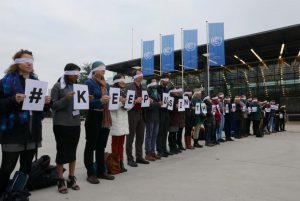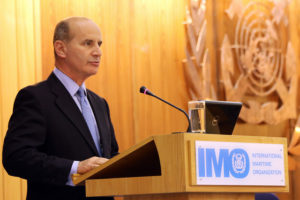When French Foreign Minister Laurent Fabius brings the UN climate summit to a close on the weekend of December 11-13, a new climate treaty will likely emerge that far outstrips the Kyoto Protocol in its geographical coverage of greenhouse-gas emissions.
Yet while the new deal will regulate far more of the world’s climate pollution than its predecessor, there will still be key sectors and activities that are not governed by the UNFCCC (the UN’s climate arm), and these represent a big share of global greenhouse gases (GHGs). How those sectors achieve their share of the big cuts needed to avoid dangerous climate change will be closely watched in the months and years to come.
All told, emissions from agriculture, aviation and shipping, and refrigerant HFC gases, total almost a quarter of GHG pollution. The complexity of the sectors that produce these emissions has meant that efforts to deal with them under the UNFCCC have either not happened, or have been largely unsuccessful.
Aviation and maritime emissions
Two key sectors that will not be covered by Paris are civil aviation and maritime transport. At negotiations for the Kyoto Protocol in 1997, nations could not agree on international measures to reduce emissions from aviation or shipping, and so delegated authority to handle the issue to the International Civil Aviation Organisation (ICAO) and the International Maritime Organisation (IMO), the respective UN agencies that govern international activity in these sectors.
The IMO estimates that in 2012, GHGs from shipping represented more than 2.5% of the global total. For its part, aviation produced 705 million tonnes of carbon dioxide equivalent (CO2e) in 2013, around 2% of the world total for the year, according to data from the Air Transport Action Group.
Since 2001, ICAO has been working towards a “market-based mechanism” that would allow air carriers worldwide to reduce emissions generated through air travel and transportation. So far, its work hasn’t impressed climate campaigners.
“Unfortunately, the current proposal for the market-based solution aspires only to stop emissions growth at 2020 levels from 2020 onwards, and to achieve this through offsetting from emissions reductions in other sectors,” Kat Watts, a policy advisor with Carbon Market Watch, said by email. “We will not know whether these measures will indeed be endorsed by ICAO until the October 2016 Assembly.”
Outside the jurisdiction of international agencies, there are numerous national initiatives to reduce emissions from aviation, but none of these are mandatory. Since 2012, the European Union has capped emissions from flights that originate or end in within its jurisdiction, but was forced to suspend coverage of flights taking off or landing outside the bloc after fierce opposition from countries including the US, China and India. The EU has reserved the right to re-impose caps on these flights if it deems ICAO’s plan to be insufficiently ambitious.
IMO regulates marine pollution through the Protocol to the International Convention for the Prevention of Pollution from Ships, known as MARPOL Annex VI. According to the IMO, these rules cover emissions from more than 98% of the world’s fleet.
The organisation has resisted calls for outright emissions cuts for shipping, saying that any cap on GHGs will harm global freight and trade. It points out that under existing rules, shipping’s share of global emissions has already fallen to 2.2% in 2012 from 2.8% in 2007. Instead, the IMO has mandated energy-efficiency measures that may reduce the carbon intensity of shipping – the amount of CO2 emitted per kilometre travelled – but not the total amount.
“What shipping cannot do is control the total global demand for cargo to be carried,” IMO Secretary-General Koji Sekimizu said in a statement. “This is directly related to growth in the global economy.”
This has not stopped climate groups from calling on the shipping and aviation sectors to set absolute limits on emissions.
“For Paris, the UNFCCC should make a clear call in the binding legal instrument, for ICAO and IMO to set sectoral targets in line with their fair share of action,” Watts said. “These should be on top of the national pledges that most countries have so far put forward”.
HFCs
Reducing emissions from the production of hydrofluorocarbons, one of the most powerful types of GHGs that are used in refrigerant gases, has been historically handled by the UNFCCC, but many chemical plants are exempt. However, a recent proposal by parties to the Montreal Protocol, an ozone gas treaty, to agree a timetable for the phase-down of HFCs, may offer a faster and more secure route towards reducing their impact.
HFC emissions are estimated by the US National Academy of Sciences to have grown from 303 million tonnes of CO2 equivalent in 2007 to 463 million tonnes in 2012, or around 1% of global emissions. This increase stems chiefly from the increased use of HFCs as a replacement for ozone-depleting gases in air conditioning.
The Montreal Protocol took effect in 1989, and was established to phase out production of gases that harm the ozone layer, in particular chlorofluorocarbon (CFC) and hydrochlorofluorocarbon (HCFC) gases used in air conditioning, fire extinguishers and as solvents. The protocol is widely viewed as a success, has limited increases in the use of ozone-depleting gases and is forecast to make reductions as early as 2020.
CFCs and HCFCs have been replaced by hydrofluorocarbons (HFCs) which, while not harming the ozone layer, are powerful greenhouse gases that have been covered under the UNFCCC. However, Montreal Protocol member nations agreed this month to set at their next meeting a timetable for a global phase-down of HFCs.
“Nothing substantial has been done under the climate convention or the Kyoto Protocol about those gases,” according to David Doniger, director of the Climate & Clean Air Program at the Natural Resources Defense Council in Washington DC. ”In the climate talks, CO2 sucks all the oxygen out of the air.”
There are two compelling reasons for the Montreal Protocol to take up regulation of HFCs, said Doniger.
“First, the only reason that HFCs are growing is that they came in as a replacement for CFCs and HCFCs,” he said. “The Montreal Protocol effectively created the HFC problem and so it has a responsibility to address it.”
“Second, we never get to the second-tier gases under the UNFCCC negotiations, and the expertise in the industries that use this gas is all on the Montreal Protocol side. It’s a pretty narrow sector.”
The result may be a division of responsibilities between the UNFCCC and the Montreal Protocol, according to Adela Putinelu, a campaigner at the Environmental Investigation Agency.
“The UNFCCC has a duty to monitor and report reductions in GHGs including HFCs,” Putinelu explained. “The amendment to the Montreal Protocol, if agreed next year, will govern actual reductions in HFC use.”
Agriculture and Forestry
Data from the UN’s Food and Agriculture Organisation (FAO) shows global emissions from agriculture, forestry and other land uses (known as AFOLU) averaged 10.2 billion tonnes a year of CO2 equivalent over the period 2010-2014, or nearly 20% of total emissions from human activity.
This category includes crops and livestock production (including the use of fertilisers that release nitrous oxide, and methane from livestock waste and digestion), forest conversion to other uses, degraded peatlands and fires. FAO estimates emissions from these sources could increase by as much as 30% by 2050 unless greater measures are taken to reduce them.
Critically, agriculture and forestry activities can also absorb or cut GHGs. Consequently, the loss of forest cover through wildfires means that not only is CO2 released by the burning, but the forest’s capacity to absorb CO2 is lost.
AFOLU emissions are partly regulated by the UNFCCC: for example, in 2013 nations agreed to establish a mechanism to reduce emissions from deforestation. However, in general countries have been unable to agree how to tackle agriculture and forestry emissions and ensuring that food production would not be affected.
By delegating control over emissions from key sectors such as transport and fluorinated gases to UN agencies and existing treaties, the UNFCCC can focus its agreement on achieving more immediate emission reductions from industry and power generation, the largest sources of GHGs.
It can also avoid jurisdictional problems that might exist were it to try to regulate transport pollution, not to mention politically sensitive issues such as agriculture where existing global food production has yet to eliminate hunger.
However, it will be critical that emission cuts from aviation, maritime transport and fluorinated gas production are seen to decline at the same pace, or there will be increasing calls for the UNFCCC to step in and regulate these sources directly, potentially at a considerable cost in terms of political delay and painfully slow discussions.







